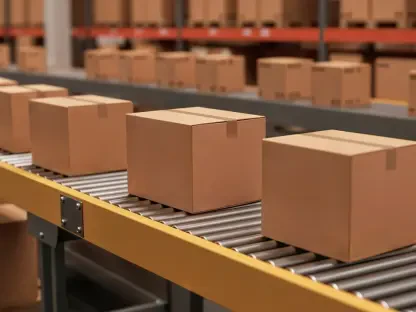The advent of Robots-as-a-Service (RaaS) has ushered in a paradigm shift in the warehousing industry, fundamentally changing how warehouses operate and strategically plan their resources. RaaS modifies deeply ingrained practices by replacing traditional capital expenditure models with a flexible subscription-based approach that integrates robotic automation into day-to-day operations. This innovative model promises to enhance efficiency while dramatically reducing financial hurdles often associated with deploying advanced technology. As the industry embraces this transition, warehouse operators are beginning to notice the strategic advantage offered by such agility, adaptability, and scalability. This article delves into the multifaceted advantages of RaaS, exploring how it tackles seasonal demand, implementation challenges, and contractual intricacies to propel the warehousing sector toward unprecedented efficiency.
Cost-Efficiency and Financial Flexibility
Mitigating Upfront Costs and Improving ROI
A significant advantage of RaaS is its ability to mitigate the hefty upfront costs traditionally associated with automation technologies. Under capital expenditure models, businesses face substantial financial outlay at the onset, which often presents a formidable barrier to entry for many operators. These initial costs can deter companies, particularly those aiming for nimbleness in rapidly shifting economic landscapes. The RaaS model alleviates financial pressure by spreading investment over a longer time frame, promoting a smoother, more predictable, and manageable fiscal landscape. Consequently, companies can reallocate funds toward other strategic initiatives, facilitating a faster return on investment. The model’s periodic payment structure enables businesses to plan resource distribution proactively, accommodating shifts in economic conditions and maximizing financial efficiency.
Dynamic Adaptability in Financial Planning
In addition to minimizing initial expenses, RaaS offers a distinct advantage in dynamic financial planning and adaptability. CapEx models impose rigid, one-time commitments that require extensive forecasting and planning, often based on limited data or assumptions about future business conditions. In a world where economic uncertainties can ravage such forecasts, operators may find themselves tied to investments that underperform or become outdated. RaaS confronts these challenges head-on, providing modular scaling based on real-time demand projections. Companies can lease additional robotic units during peak periods or reduce subscriptions when demand subsides, ensuring that investments correlate with operational realities. This adaptability nurtures a resilient financial approach, allowing businesses to modify their strategies and plans concurrent with evolving market demands without succumbing to the stifling inertia characteristic of static infrastructure investments.
Scalability and Seasonal Adjustments
Accommodating Growth and Change
The RaaS model exhibits intrinsic scalability, empowering businesses to adjust capacity based on actual requirements rather than speculative predictions. Warehousing demands are seldom static; they vary dramatically across seasons and economic cycles, rendering rigid investment models obsolete. The subscription-based nature of RaaS allows operators to start small while incrementally scaling operations as demand increases. This proficiency is particularly relevant in industries where warehousing plays a pivotal role, catering to fluctuating market conditions efficiently. By commencing at a manageable scale and expanding incrementally, operators can achieve a tailored growth trajectory that complements their unique business landscape. This adaptability marries efficiency with cost-effectiveness, ensuring that resources match requirements exactly, reducing waste, and augmenting agility.
Addressing Seasonal Peaks With Precision
Moreover, RaaS contributes to optimizing efficiency by providing solutions to handle seasonal peaks with precision. Traditional CapEx models, reliant on prior resource additions, often compel businesses to stockpile resources during low demand periods, incurring unnecessary costs. Warehouses face significant challenges during peak seasons such as the holiday rush, necessitating immediate resource augmentation to meet increased demand. RaaS enables dynamic leasing that adjusts operational capacity accordingly, offering robotic units specifically for periods of heightened activity and returning them during downturns. This versatility aligns closely with business needs, maximizing operational resources with optimal expense management. The model promotes efficient operations by ensuring that investments are not only timely but also economically justifiable, entrenching a lean business model that responds astutely to seasonal cycles without financial encumbrance.
Continuous Enhancement and Operational Synchronization
Integrating Software and System Updates
The symbiotic relationship RaaS fosters between continuous enhancements and operational management is another significant boon. Warehouse operations increasingly rely on cutting-edge technology and innovations to maintain a competitive edge and streamline processes. RaaS contracts facilitate regular updates to all software and systems, ensuring that warehouses employing autonomous robots benefit from the latest advancements without contingencies. These automatic enhancements are delivered seamlessly across all operational units, ensuring synchronized improvements without incurring additional project costs or requiring extensive intervention. Continual delivery of these enhancements fosters business growth by providing cutting-edge efficiencies without the burdens typically associated with technological updates.
Synchronizing Customer Success with Industry Innovation
By streamlining these updates and integrating operational advancements into regular subscription channels, RaaS aligns industry innovation with customer success. Every exception-free cycle of system improvements becomes a catalyst for collective progress within the warehousing industry. Whether through advanced analytics or automated problem-solving, RaaS empowers operators to explore new efficiencies without substantial manual oversight, entrenching a path of continual innovation long-term. Such synchronization strengthens relationships between service providers and customers, creating a seamless business environment conducive to adaptation and success. This convergence of efficiency and innovation becomes a driving force behind sustainable growth, challenging the traditional perceptions of warehousing operations and paving the way for revolutionized industry practices.
Contracts and Technical Considerations
Contrasting SaaS and RaaS Models
While similarities exist between Software as a Service (SaaS) and RaaS contracts, fundamental differences warrant careful attention. Both models embrace annual subscription agreements, initially binding users for a specified duration, commonly three years. Like SaaS, implementation fees cover varied setup tasks—design, networking, project management, and staff training—aimed at ensuring infrastructural efficiency. However, the licenses between the two diverge significantly in practical deployment. SaaS licenses can vary across enterprise-wide or user-centric formats, whereas RaaS assigns licenses based on site usage irrespective of user count, reflecting the varied demands of warehouse environments. This distinction emphasizes practical execution, where RaaS adapts per site—important for maintaining relevance in deployment when connecting multiple warehouses using automated solutions.
Maintenance and Support Frameworks
The comprehensive maintenance and support frameworks that RaaS provides further highlight its practicality. Much like SaaS, RaaS incorporates regular system updates and enhancements within its subscription model. However, a notable distinction lies within hardware support structures, as these services include Return Material Authorization processes designed specifically to facilitate hardware repairs, minimizing downtime and ensuring uninterrupted service delivery. By developing a robust support system, RaaS acknowledges the importance of maintaining high operational standards without burdensome administrative oversight. These frameworks assure customers that their operations are routinely optimized while reducing interruptions across service life cycles—essential for attaining unyielding standards in operational efficiency.
Synchronizing Mutual Objectives
The Role of Cooperation for Success
Mutual cooperation between the RaaS provider and clients plays a decisive role in optimizing operations under this model. Customers share essential pre-installation and post-installation responsibilities, ensuring that all adjustments related to site infrastructure are performed effectively. Facilitating these preparations might necessitate reconfiguring site resources like internet service lines, power feeds, or minor structural alterations. Such responsibilities foster homogeneity in the execution phase, ensuring seamless integration across operations. RaaS emphasizes setting transparent expectations and role division, guaranteeing that all parties are unified toward the common objective of efficiency and progress.
Importance of Comprehensive Contracts
A well-articulated contract that aligns service providers and warehouse operators is paramount for ensuring expectations are met and roles are effectively divided. Through diligent evaluations of organization-specific requirements, companies can design contracts that epitomize their strategic targets. These agreements will accommodate a robust service framework, fostering reliability, transparency, and systematic growth. By emphasizing contract clarity and fostering mutual understanding, clients can capitalize on the comprehensive advantages offered by RaaS—driving efficiency in operations, promoting sustainable growth, and facilitating change in the sector with confidence.
Future Pathways and Industry Evolution
Embracing New Solutions
With the industry shifting toward intricate automation solutions, RaaS symbolizes a promising future direction, blending flexibility with operational convenience and efficiency. As operators transition away from archaic, static models of investment, they recognize the potential inherent in adaptable service-based frameworks. This transition supports functional coalescence, tailoring business strategies to reflect evolving demands while promoting convenience in operation. The continuous application of RaaS has gradually entrenched this philosophy, presenting a viable, strategic outlook to industry players poised to adopt such forward-thinking solutions.
Envisioning Sustainable Success
The success of a Robot-as-a-Service (RaaS) model hinges heavily on the collaboration between the service provider and the clients. This partnership is fundamental to streamlining operations effectively. Clients are tasked with both pre-installation and post-installation duties, which are crucial for making sure all adjustments to the site’s infrastructure are carried out smoothly. This might involve reconfiguring site resources such as internet service connections, power supplies, or making minor structural modifications. These responsibilities are vital for achieving uniformity in the implementation phase, facilitating seamless integration across various operations. The RaaS model prioritizes clear expectations and defines the roles of each involved party. This ensures that everyone is aligned toward the shared goal of enhanced efficiency and forward progress. Such clarity and shared responsibilities allow for a cohesive approach, ultimately benefiting all parties involved and driving the overall mission of operational excellence and technological advancement.









